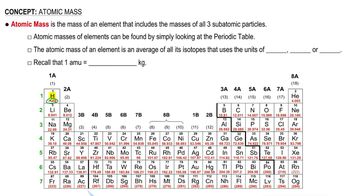The atomic mass of fluorine is 18.998 amu, and its mass spectrum shows a large peak at this mass. The atomic mass of chlorine is 35.45 amu, yet the mass spectrum of chlorine does not show a peak at this mass. Explain the difference.
Ch.2 - Atoms & Elements
Chapter 2, Problem 74
The atomic mass of copper is 63.546 amu. Do any copper isotopes have an exact mass of 63.546 amu? Explain.
 Verified step by step guidance
Verified step by step guidance1
Understand that the atomic mass of an element is a weighted average of the masses of its isotopes, based on their natural abundance.
Recognize that isotopes are atoms of the same element with different numbers of neutrons, and thus different masses.
Consider that the atomic mass of copper (63.546 amu) is not necessarily the mass of any single isotope, but rather an average value.
Identify the two main isotopes of copper: Cu-63 and Cu-65, with masses approximately 62.9296 amu and 64.9278 amu, respectively.
Conclude that no single isotope of copper has an exact mass of 63.546 amu, as this value is an average of the isotopic masses based on their relative abundances.
Key Concepts
Here are the essential concepts you must grasp in order to answer the question correctly.
Atomic Mass
Atomic mass is the weighted average mass of an element's isotopes, measured in atomic mass units (amu). It reflects the relative abundance of each isotope in nature and accounts for the mass of protons, neutrons, and electrons. For copper, the atomic mass of 63.546 amu indicates that this value is not necessarily the mass of any single isotope but rather an average of all isotopes present.
Recommended video:
Guided course

Atomic Mass
Isotopes
Isotopes are variants of a chemical element that have the same number of protons but different numbers of neutrons, resulting in different atomic masses. For copper, the most common isotopes are Cu-63 and Cu-65. The existence of isotopes means that while the atomic mass of copper is 63.546 amu, no single isotope will have this exact mass due to the presence of different neutron counts.
Recommended video:
Guided course

Isotopes
Exact Mass vs. Atomic Mass
Exact mass refers to the precise mass of a specific isotope, calculated based on the number of protons and neutrons it contains. In contrast, atomic mass is an average that incorporates the relative abundances of all isotopes. Since the atomic mass of copper is an average, it is unlikely that any isotope will have an exact mass of 63.546 amu, as isotopes will have whole number masses that differ slightly from this average.
Recommended video:
Guided course

Atomic Mass
Related Practice
Textbook Question
Textbook Question
An element has two naturally occurring isotopes. Isotope 1 has a mass of 120.9038 amu and a relative abundance of 57.4%, and isotope 2 has a mass of 122.9042 amu. Find the atomic mass of this element and identify it.
3
views
Textbook Question
An element has four naturally occurring isotopes with the masses and natural abundances given here. Find the atomic mass of the element and identify it.
Isotope Mass (amu) Abundance (%)
1 135.90714 0.19
2 137.90599 0.25
3 139.90543 88.43
4 141.90924 11.13
Textbook Question
Bromine has two naturally occurring isotopes (Br-79 and Br-81) and has an atomic mass of 79.904 amu. The mass of Br-81 is 80.9163 amu, and its natural abundance is 49.31%. Calculate the mass and natural abundance of Br-79.
4
views
